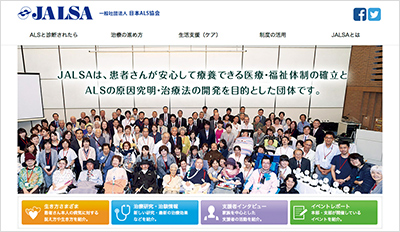Connecting to Hope
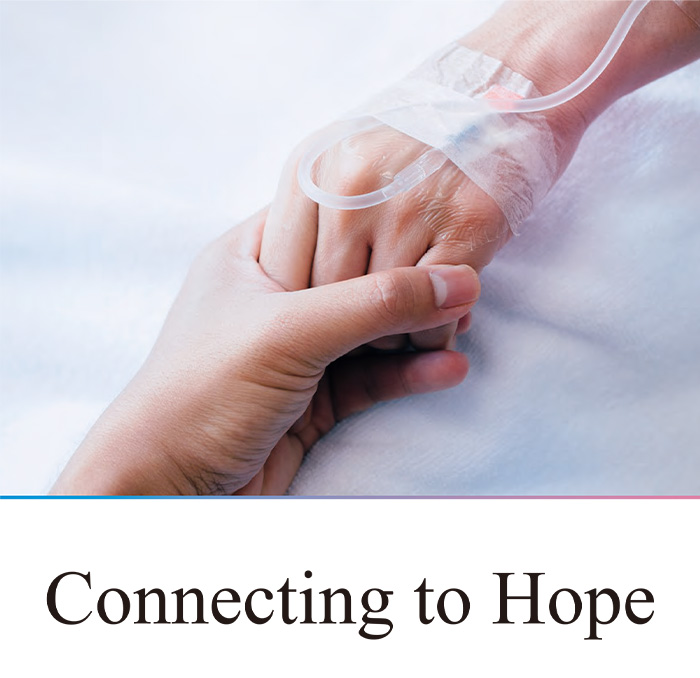
Advances in healthcare have brought unprecedented health and longevity to
mankind. Nevertheless, many people continue to battle disease.
We would like everyone to know about the incurable disease known as ALS, amyotrophic lateral sclerosis.
The Ice Bucket Challenge that was popular in 2014 increased ALS awareness, and we hope the information here
will also help spread understanding of the disease and help patients and their families live better lives.
Our objective is to contribute the health of people around the world.
Create a system for all of society to help battle incurable diseases by providing information and raise awareness.
Through nonstop research, develop and provide treatment methods and drugs as quickly as possible.
Provide hope for the future by battling against diseases that could potentially afflict anyone.
What is ALS?
ALS, or amyotrophic lateral sclerosis, is a progressive disease that affects motor nerve cells and causes the body to gradually lose the ability to move. The cause of ALS is not completely understood, and it remains a disease that is considered to be incurable.
As ALS progresses, brain signals fail to reach the muscles, causing them to them weaken. The initial symptoms of the disease vary but can be broadly divided into two types. One is difficulty moving the limbs, making it hard to hold heavy objects or move the legs forward. The other is difficulty moving the mouth, which often causes slurred speech or a nasal voice. The symptoms gradually spread throughout the body, making it difficult for a patient to walk, eat, and even breathe on their own. In addition, trouble swallowing food makes it difficult to obtain the necessary nutrition. ALS does not affect the senses of sight, hearing, or touch, and although they are unable to make their body move the way they want it to, people with ALS are fully alert and conscious.
Most people who develop ALS are in their 50s to 70s, and there are estimated to be about 10,000 ALS patients in Japan. Every patient is different, but the disease tends to progress rapidly, and the average life expectancy after onset is generally three to five years. Longer-term treatment is currently available through the use of respiratory equipment, intravenous feeding, and gastrostomy feeding. Patients often find it difficult to talk when they are using respiratory equipment, and alternative ways have been devised to enable other means of communicating.
ALS remains incurable, however, progress toward a cure is advancing every day in genitive research and the development of regenerative medicine and medical devices. Identifying and properly treating the symptoms early is critical because treatment begun early is now able to slow the progression of the disease.
However, screening and diagnosis is often late because the range of symptoms of ALS make it difficult to distinguish from other diseases and because the relatively few number of cases have led to low general awareness of ALS. Right now, increasing public awareness and understanding is one of the best ways to fight ALS.
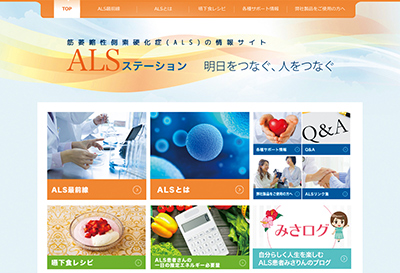
We invite you to visit our ALS Station "Connecting to Tomorrow, Connecting to People" website where we provide information about ALS pathology, treatments, related knowledge, and support systems aimed at raising awareness and understanding about ALS.
The ALS Station "Connecting to Tomorrow, Connecting to People" website (Japanese language only)
ALS and dysphagia diet
Patients with ALS lose weight for a variety of reasons. The weight loss greatly affects their medical condition, so proper nutritional management from the beginning is essential. As the symptoms progress, patients begin to have difficulty swallowing, called dysphagia, making it hard to eat and drink. Consuming food is critical to controlling the weight loss, and the special "dysphagia diet" helps patients eat by softening and changing the shape of food to make it easy to swallow.
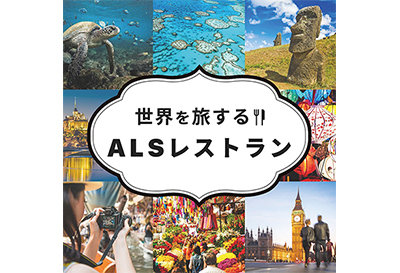
The ALS Station website "Connecting to Tomorrow, Connecting to People" provides recipes for a dysphagia diet that are designed to prevent malnutrition while enabling the patient to enjoy the same foods as their family members. In addition, the website's ALS Action! Page has a section titled "ALS Restaurants Around the World" introducing recipes and preparation methods for ethnic dishes meeting the food texture and nutritional needs of ALS patients.
Thoughts on Patient Groups
A little strength from each person makes a powerful group
ALS has long been viewed as a tragic illness with an image of patients staring at the ceiling with no hope of recovery. However, ALS patients are fully conscious and aware. With proper support, patients can continue to be active even as the disease progresses. Patients are not alone, there is a steadily expanding community of support.
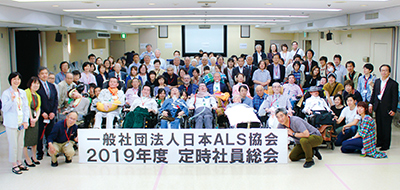
Expanding awareness of ALS
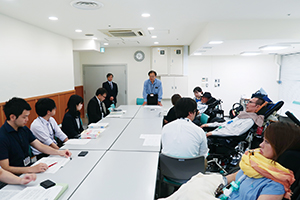
The Japan ALS Association is working with the government to further develop patient support systems.
ALS upends daily lives, and patients need ongoing medical care as well as long-term care, nursing, and welfare support. These create a substantial financial burden for patients, who need support not just from their families but from their communities as well. Support systems are gradually improving, but many patients are still without adequate support and are living in difficult circumstances.
The Japan ALS Association is an organization working to help patients with these circumstances. The association brings people together into a supportive community centered on patients and their families with the aim of creating a society where ALS patients can live with peace of mind.
The Japan ALS Association was created in response to the moving book by KAWAGUCHI Takehisa about his battle with ALS. When Kawaguchi, who was the association's first chairman, wrote his book, very little was known about ALS. People with ALS were socially isolated because the cause of the disease was unknown, and many thought it could be contagious. Since there was no treatment, doctors did not tell patients what the disease was. Kawaguchi's description of his experience brought together patients and their caretakers across the country. Communication is vital for all ALS patients, and the ability to share their thoughts and have people they can rely on is a hugely reassuring. Volunteers formed an association to work together to promote a correct understanding of the disease and the need to support patients.
With the help of patients and others, the association worked to improve the system for medical support and greatly enhanced the quality of life of patients and their caregivers. Particular progress has been made in creating systems for home healthcare. The association provides a broad range of support, including easing the financial burden by lending otherwise expensive respirators and communication devices, and successfully petitioning the government to include procedures like mucus suction that caregivers are allowed to provide with in-home services. The association is active in many areas, including seeking to persuade the government to increase the budget for ALS research and support. The association established the ALS Fund and is working with research institutes, universities, and pharmaceutical companies to promote development of treatment methods.
Finding a cure
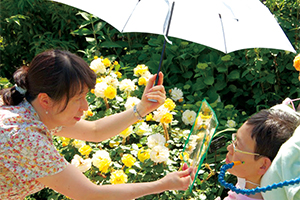
An ALS patient communicates by using eye movement to select characters on a transparent letter board
ALS research and support has made large strides in recent years. New medical equipment, portable respirators, and computers with eye-tracking technology are helping patients live more enjoyable and meaningful lives. Nevertheless, the level of medical and long-term care varies greatly across regions. These differences are not limited to patients with ALS, they also exist for other diseases and modern social issues, such as aging populations. As such, pursuing solutions for ALS will also help address wider social issues. The Japan ALS Association is seeking to establish equal care to patients nationwide, creating employment opportunities for ALS patients, and engaging in various activities to connect with hope until a cure is found for ALS.
General awareness and understanding of ALS are still insufficient. The association is using its status as a nationwide organization to raise awareness by various means, including disseminating information about ALS and supporting counseling between ALS patients and healthcare workers. The association continues to grow by joining in meetings with patients and their families and recruiting patron members who provide financial support.
Japan ALS Association
The Japan Amyotrophic Lateral Sclerosis Association was established as a non-profit organization in 1986 and became a general incorporated association in 2012. With the goal of realizing a society where ALS patients can live with full dignity as human beings, the association seeks to "battle together and walk together with ALS patients" by investigating the cause of ALS, promoting treatment research, and improving the medical treatment conditions for patients. Association members are primarily patients, their families, and people who have lost family to ALS, and also includes many people in the medical, healthcare, and welfare fields as well as researchers and the general public. The members are a community with ALS patients playing active roles in a wide variety of activities aimed at creating an inclusive society. The Japan ALS Association is a member organization of the International Alliance of ALS/MND Associations and participates in medical symposiums and other events promoting international exchange of information about ALS.
Developer Insight
Hope for one patient is hope for all patients "ALS treatments from Japan to the world"
In 2015, Japan approved a new ALS treatment that uses an intravenous drip to suppress the progression of ALS. The new treatment was much anticipated by patients around the world, who for the past 20 years had been limited to only a single treatment option. A project is currently under way to develop the treatment created in Japan for use worldwide.
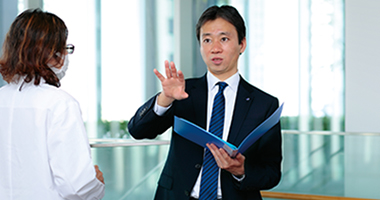
- TAKEI Koji
- Mr.Takei joined Mitsubishi Chemical as a member of pharmaceutical formula research after studying engineering at university. Desiring to be closer to the user, he changed positions to become the member of global clinical development. While working for Mitsubishi Tanabe Pharma in the United States, he played a central role developing the application to the U.S. Food and Drug Administration for approval of the ALS drug Radicava.
ALS treatment for patients around the world
When our ALS treatment was approved in Japan, I was in the United States. Developing treatments for ALS is extremely difficult, as evidenced by the lack of new drugs for about 20 years. ALS treatments are needed all over the world, so when I heard that the application for approval was successful in Japan, I knew that we had to seek approval in the United States.
Selling a treatment overseas requires approval from each country you want to sell it in. The United States is the world's largest market for pharmaceuticals, and receiving approval there will have a major influence on the ability to sell the treatment in other countries.
Our biggest concern when we were applying to the U.S. Food and Drug Administration (FDA) for approval was that the subjects of the clinical trial data were all Japanese patients. Applications overseas usually require clinical trial data obtained in that country or region. However, starting clinical trials in the United States from the very beginning would take too much time, so we organized all the data from Japanese researchers and from past clinical trials on stroke treatments in Japan and Europe into a coherent story that we hoped would convince the FDA. Analyzing a huge amount of data was a daunting task, and there were many obstacles due to differences in thinking between Japan and the United States. Nevertheless, we completed the task because we were strongly determined to get this medicine to patients.
In the end, the FDA gave us a high assessment for our materials and did not require any additional clinical trials. Supported by the expectations of patients and others, the FDA approved the treatment in May 2017, which was exceptionally fast.
Radicava
Radicava is the drug name used in the United States with the generic name Edaravone, which was originally developed in Japan as a treatment agent for cerebral infarction. Radicava is an intravenous drip infusion treatment for ALS administered over a total of 28 days, including the dosing period and drug-free period. Originated in Japan, as of 2020, Radicava has been approved for use in seven countries and plans are under way to receive approval in many more countries around the world.

A better treatment for everyone around the world
While we were submitting our application to the FDA, I realized that we needed to quickly develop an oral treatment. Radicava is administered via intravenous drip, but the convenience of an oral drug could really improve the quality of life of patients. Drugs that are injected or taken orally are usually very different, but we compiled many years of research data that showed it was possible to convert treatments into oral drugs. It's not easy, of course, but we owed it to the patients to try. Beside the team developing the injectable treatment, we set up a dedicated team to focus on creating an oral treatment; and we told them to work as quickly as possible. Thanks to the efforts of R&D members in Japan and the United States, and the cooperation of patients and doctors, the development of the oral drug reached the final stages of clinical trials in 2020, and we are aiming to apply for approval as soon as possible.
Still, we have only just begun. We will continue working not just to slow the progression of ALS, but until we find a cure. We are continuing to do everything we can to develop better therapeutic agents.
- *The contents of this article are current as of the time of the interview.
- Related information

